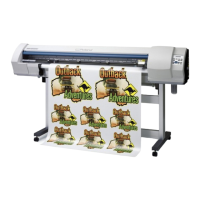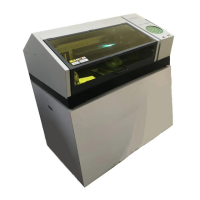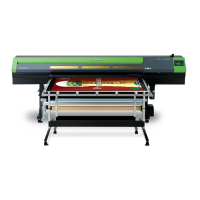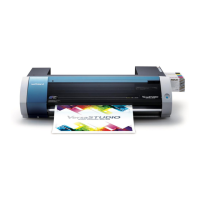Do you have a question about the Roland VersaCamm SP-300V and is the answer not in the manual?
Explains hazard symbols and general safety advice for machine use.
Details risks associated with incorrect operation, fire, burns, and toxic gases.
Covers warnings about electrical shock, short circuits, and fire risks.
Safety measures for ink, cleaning liquid, and discharged fluid hazards.
Identifies and explains the meaning of machine warning labels.
Highlights the key capabilities and functionalities of the machine.
Details the names and functions of the printer's various parts.
Step-by-step guide for turning the printer on and off.
Instructions for correctly loading and cutting media.
How to adjust temperature settings for ink adhesion and drying.
Procedures for preparing and initiating output.
Steps to take when ink cartridges are empty or need replacement.
Detailed instructions for executing cutting tasks on the media.
Routine cleaning and upkeep procedures for the machine.
Troubleshooting when standard head cleaning is ineffective.
Manual procedure for cleaning print heads using a specific kit.
Instructions for replacing wipers, ink absorbers, and blades.
Adjusting settings to match different media types and thicknesses.
Techniques and settings for handling diverse media.
Configuring printer behaviors like sleep mode and ink status response.
Instructions for using crop marks for accurate alignment.
Fine-tuning cutting parameters like force, speed, and offset.
Steps for draining ink and generating system reports.
An overview of the printer's menu structure and available options.
Troubleshooting steps when the printer unit or heaters are not functioning.
Solutions for problems like coarse prints or misaligned cuts.
Actions to take when the media gets jammed in the machine.
Troubleshooting issues related to media wrinkles, shrinking, or unstable feed.
Steps to resolve cases where the print head carriage stops unexpectedly.
Guidance for interpreting and resolving various error messages.
Details on compatible media types, sizes, and weights.
Specifies the maximum printable and cuttable dimensions.
Information on blade types, force requirements, and expected service life.
Comprehensive list of technical specifications for the machine.
| Resolution | Up to 1440 dpi |
|---|---|
| Connectivity | USB |
| Print Technology | Piezoelectric Inkjet |
| Media Handling | Roll-fed |
| Ink Colors | Cyan, Magenta, Yellow, Black |
| Media Thickness | Max. 1.0 mm (39 mil) with liner |
| Media Types | Vinyl, banner, paper, film |
| Power Requirements | AC 100 to 120 V ±10 %, 50/60 Hz |
| Operating Environment | Temperature: 20-32°C, Humidity: 35-80% (non-condensing) |












